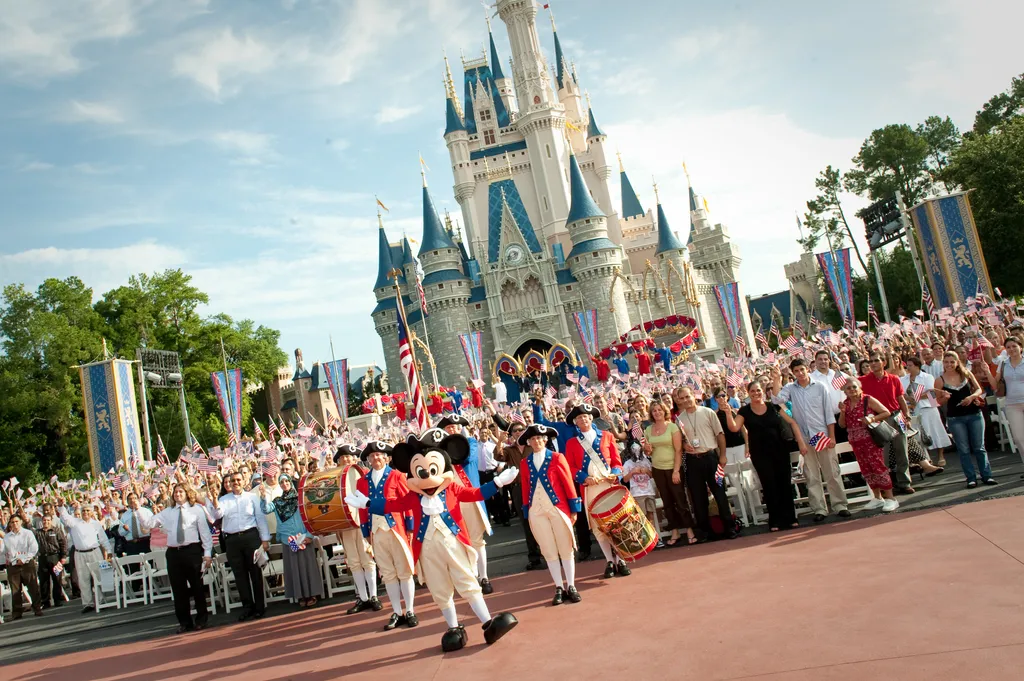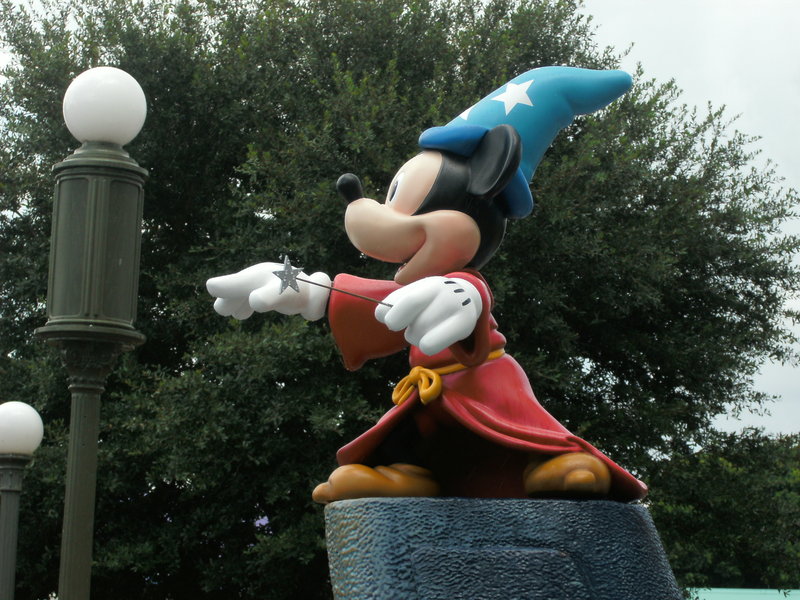There are places on this planet where people explore their wildest fantasies. Luckily, I grew up near one. That creative environment for me stood about 88 miles North East from my childhood home on the edge of Orlando, Florida. It is called Disney World. Over the years, my family and I would venture up there from time to time to check out the various theme parks. We would ride thrilling roller coasters, experience movie scenes like never before, and got up close and personal with animals from the wild. Many of the most exciting rides were found in the main park, but there was a captivating indoor theme park in Downtown Disney that kept us coming back for more. That five-story building was essentially an interactive arcade of the future known as DisneyQuest. Guests would enter the first-floor lobby and would then be transported via a “magic” elevator to the third floor atrium at the start of their visit. On the second floor was where I had my first virtual reality experience ever. I will never forget putting on a head-mounted display (HMD) and taking Aladdin’s Magic Carpet Ride into the computer-generated realm of Agrabah, collecting gems along the way. My dreams of interacting with the characters from one of my favorite animated films of all time had finally come true; thanks to Disney.
Fast forward to the present, and virtual reality is a hot topic of conversation. Tradeshows and conferences are popping up everywhere with VR at the center focus. After decades of research and experimentation, consumer virtual reality headsets are finally hitting the market, projected to enter people’s homes over the next few years by the millions. Almost out of nowhere, VR captured a lot of media attention. Yet, many don’t realize that proofs of concepts for virtual reality began long before the recent hype cycle. For ages, large corporations like Disney allowed people to immerse themselves in fantasy worlds.
During the Game Developers Conference (GDC) in 2015, a recent member of Disney’s Imagineering team gave a talk about the expansive history of Disney’s work in VR. Bei Yang (the Creative Technology Designer Lead) led a talk called “Practical Virtual Reality for Disney Themeparks.” Yang discussed over 20 years of Disney’s virtual reality research and deployment that day.
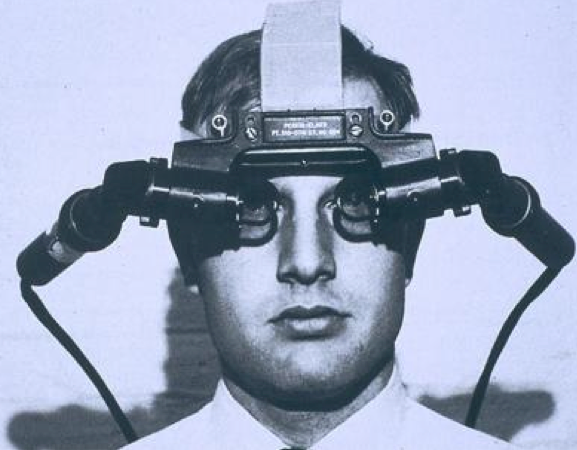
Right from the beginning, Yang honored some of the original VR pioneers by starting out with a quote from a computer scientist who influenced virtual reality about half a century ago. That person Yang quoted was Ivan Sutherland in 1965. Sutherland is the guy who invented Sketchpad in 1962, which was innovative program that led to alternative forms of interaction with computers. A few years later, Sutherland created the first virtual reality and augmented reality head-mounted display system with the help of another computer scientist named Bob Sproull. They called the VR headset ‘The Sword of Damocles’ in reference to a Greek mythological weapon. Although the device was cumbersome and had wires hanging from the ceiling, it founded the ideas that would eventually turn into what we know as virtual reality and augmented reality today. At GDC, Yang brought the audience all the way back to where some of the ideas for VR originated. From there, Yang progressed forward through VR’s timeline after that.
The next stop on the virtual reality tour was the “failed” revolution of the 1990s. A startup called VPL Research worked a lot in the virtual reality space in the late 1980s; but most remember the time shortly after that. Yang definitely discussed the biggest boom of VR history (prior to what is happening now) that occurred in early 90s. This got a ton of people hyped for the emerging medium. Nintendo’s Virtual Boy hit the market selling over 750,000 units[1]. Sega released a head-tracked VR HMD for arcade use, and around the same time, DisneyQuest was born as well.
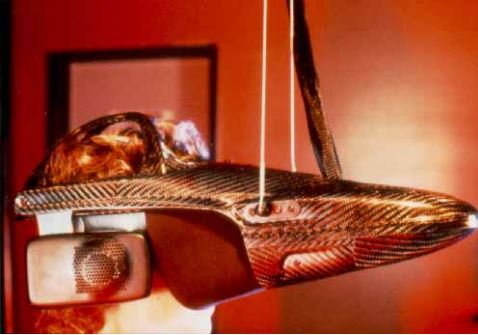
Beginning in July of 1994, researchers at Disney’s Imagineering deployed a virtual reality system into DisneyQuest. That experience was Aladdin’s Magic Carpet Ride. It used a rather large head-mounted display. People would sit on physical setup that looked much like a jetski. There was even places to hold on to during the ride. According to a scientific document by Randy Pausch, Jon Snoddy, Robert Taylor, Scott Watson, and Eric Haseltine, “every twenty minutes a group of up to 120 guests was given a brief technical lecture about VR followed by a demonstration where four guests were selected to ‘fly a magic carpet.’”
The attraction was intentionally hidden in a remote area of the park. Most guests entered not because they had a strong interest in VR, but because our attraction was “the next thing” to do. Guests could not volunteer to fly; they were selected by the ride operators. The operators maintained a strict policy of avoiding guests who showed an active interest in VR. Therefore, rather than pertaining to a small subset of VR enthusiasts, we believe that our results are essentially a fair cross section of the theme park population. Some guests did decline the invitation to fly. Interviews revealed this was primarily due to stage fright, not an aversion to trying VR.
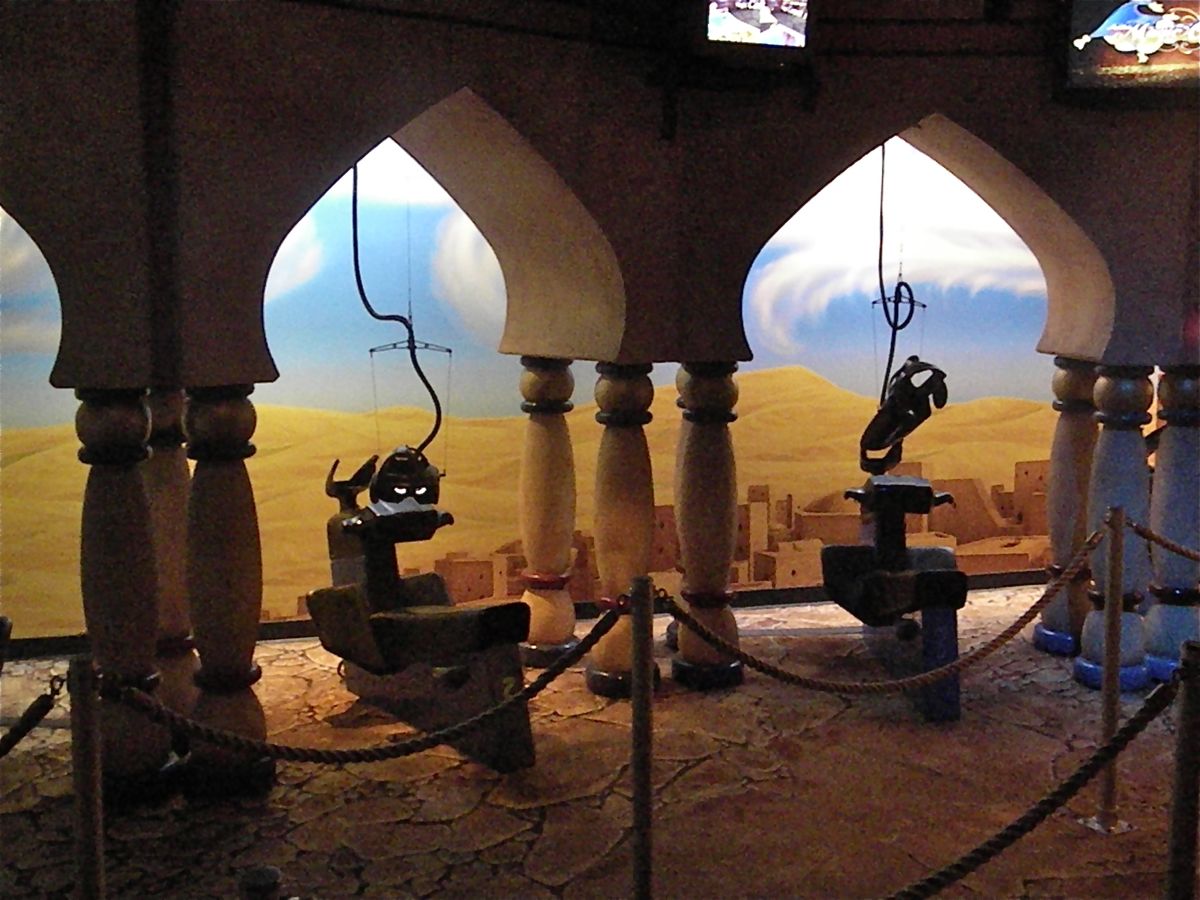
That virtual reality trial by Disney’s Imagineering lasted from July 1, 1994 all the way through to September 8, 1995. They uncovered many key findings, and the developers wrote down their general observations showing what the reactions were like.
We were able to sustain the illusion that the guests were in another place. Men and women of all ages suspended disbelief and a large number reported the sensation that they were “in” the scene. This is hard to conclude from exit surveys, but guests also provided unsolicited cues, such as panicking or ducking their heads as they approached obstacles.
Guests cared about the experience, not the technology. Most guests had no concept of how VR works, nor did they care. They focused on the sensation, which was exhilarating for most guests. Many guests shouted “Wow!” or “Whee!” in their first thirty seconds.
The experience was overwhelming. Between sensory overload and the task of trying to control the carpet’s flight, many guests were so cognitively taxed that they had trouble answering questions early in their flights.
Guests needed a goal. If not given a specific goal, guests would ask “What should I be doing?”
Guests needed a background story. We found that giving as much context as possible about the scene helped reduce the severity of the transition from the real to the virtual environment. Background story is the set of expectations, goals, major characters, and set of rules that apply to the virtual world. Ironically, in lower fidelity, less believable VR systems, this need for background story may not be as evident. We believe it is the abrupt transition into a believable virtual world that is problematic. Performing a good transition from the real to the virtual world is an open challenge.
Guests liked exploring, and seeing new spaces. Most guests did not spend much time studying detail in a given place; they tended to move on quickly to new vistas.
Guests did not turn their heads very much. This could be because they were piloting a vehicle, or because they were not accustomed to being able to turn their heads when looking at displayed images. For many, we believe the latter. Guests often watched characters “walk out of frame,” as would happen with television or movies. Our strongest indication came from many pilots where we waited 90 seconds into their flight, then explicitly told them to turn their heads. At that point, they clearly had the “aha” of the head-tracking experience. While we suspect that different content would be more conducive to head turning, head tracking is far enough from most guests’ experiences with film and television that we suspect this will be a problem for many systems.
Controlling the carpet was a problem for many guests. This prompted the addition of test flights before the show began. Many guests flew out into the desert or up above the city to find a space where there were fewer obstacles, making flight easier. Although we could have had the magic carpet fly itself, our surveys indicated that the control and freedom are important parts of the experience. Six-axis control is a very difficult problem and an important design challenge is finding appropriate control constraints.
VR must be personally experienced. In addition to the 45,000 guests who piloted carpets, we had over one million audience members who observed the pilots’ progress on display monitors. The audience members enjoyed the show and understood that something fascinating was going on with the pilots, but it was clear that VR is foreign enough that most people can not fully comprehend it without direct personal experience. Audience members often asked if the pilots could see or interact with each other.
The research team went on to describe ideas surrounding presence and immersion in further detail. It also documented people’s reactions to virtual characters, motion sickness, the differences between men and women, VR for the disabled, how to tell stories in virtual reality, controlling the narrative, using sound, and much much more.
The Aladdin virtual reality ride was not the only setup that used a head mounted display. Another simulation at DisneyQuest was on the fourth and fifth floors of the building. On both of the levels, specialized space crafts hung over a edges as if they were ready to blast off into space. In the game, according to AllEars.net, “teams of six are instructed by Mistress Khan on the subtleties of a laser sword and then sent off to do battle with super villains. Players wear virtual reality helmets and are a kick to watch as they swing their swords at seemingly invisible prey.” The attraction was eventually shut down and replaced with restaurant seating for the food court. [2]
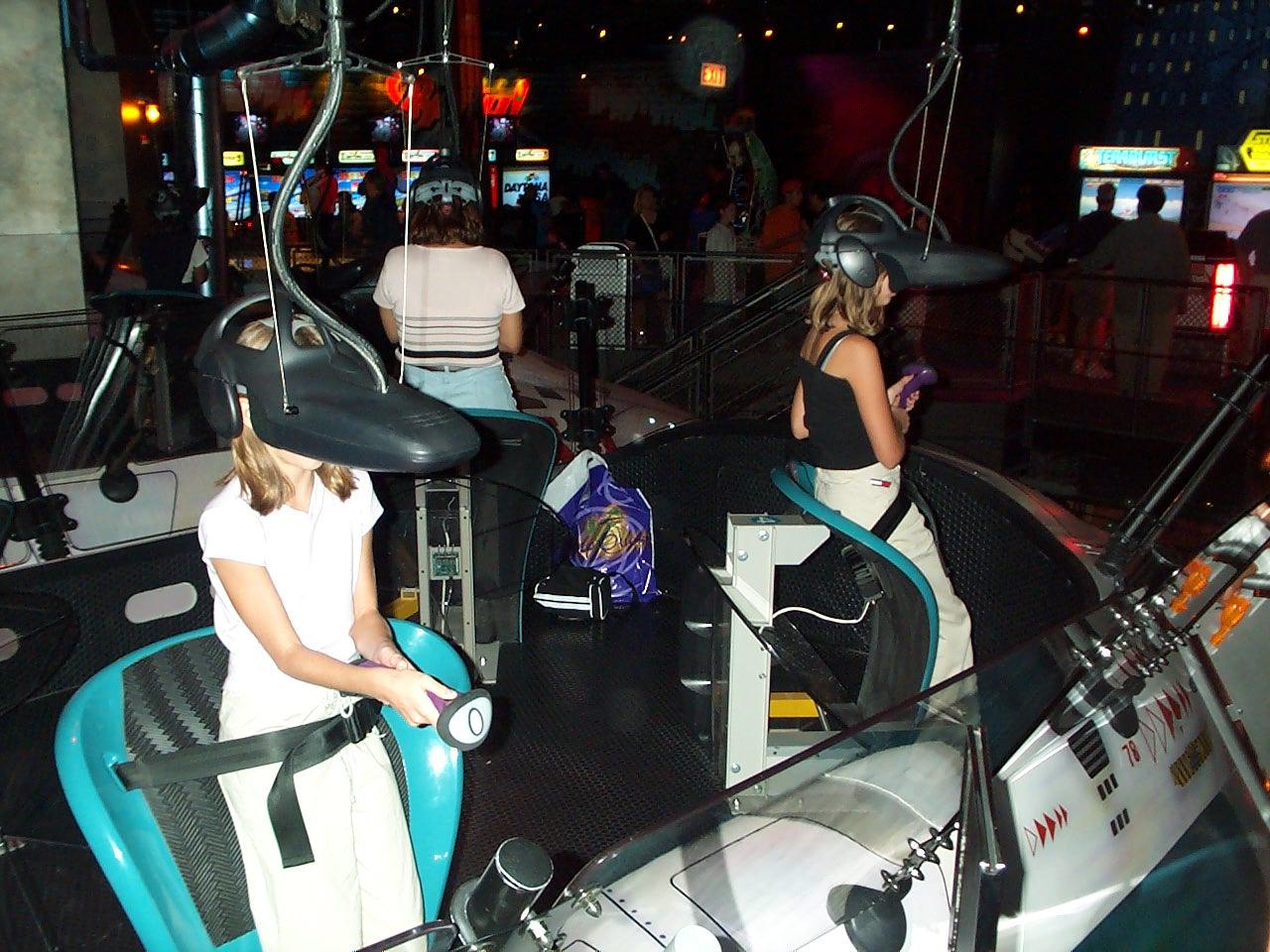
Although mass adoption of VR on a consumer level really never took off after that (until now), Disney kept experimenting with it. Instead of using head-mounted displays, they went more towards what is known as a cave automatic virtual environment (CAVE) system. Rather than using one screen or two, several ‘screens’ surround a groups of people had images projected on to them. Putting distance between the person and the scene increases the resolution capabilities the system. Having multiple screens initiates a higher field of view (FOV). Combining the two allowed Disney to immerse users further into virtual worlds; more than HMDs could do at that time.
One example of a CAVE-like system created by Disney’s Imagineering is called Soarin’ Over California. The production teams shot the scenes in IMAX 70mm stock film, which is a wide high-resolution film gauge typically used in still and motion picture photography. The term that Bei Yang kept repeating during the GDC presentation was “eye-limiting resolution.” Depending on where one sits on the Soarin’ Over California ride, the quality of the images is so good that the person perceived the objects projected on to the screens as real. There was even puck-like objects placed above the riders that emitted smells as they went through the scenes. A walkthrough video of the experience is on Youtube.
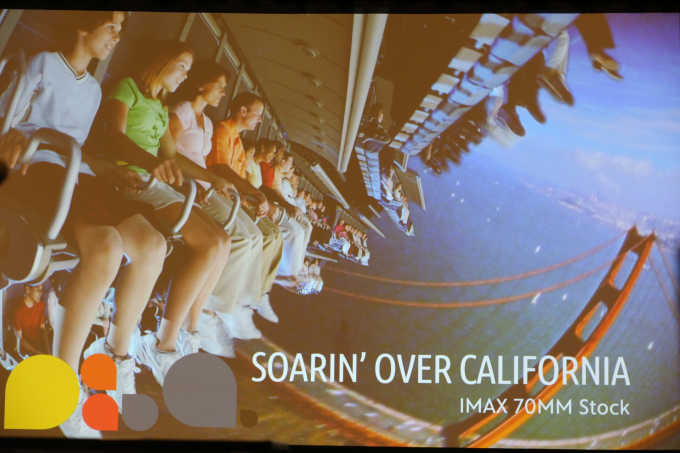
Another example of an eye-limiting resolution simulation is found at DisneyLand in Paris, France on the Ratatouille: The Adventure ride. People hop into mice-mobiles that are pre-attached to designated tracks. While the riders wear specialized glasses, images projected with multiple blended 4K projectors on to a spherical screen produces the 3D effect. This ride also had smells integrated, in addition to heat. A walkthrough video for the Ratatouille ride is also available on Youtube.
Goofy’s Paint ‘n’ Play House in Tokyo’s Disney theme park uses projectors to augment the scenes too. Ordinary objects are changed in an instant with the customized system. People become immersed within Goofy’s room during the experience. They can shoot blasters into the virtual environment. This type of setup and others like it a Disney show that virtual reality can extend beyond the typical HMD.
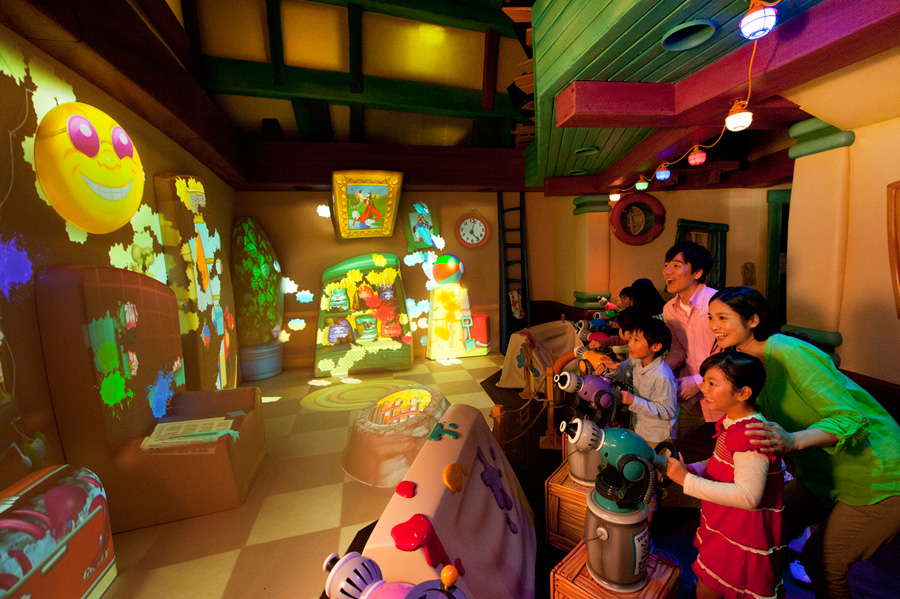
Yet another example of an interactive ride at Disney is Toy Story Midway Mania! People get into the ride and can pull strings to shoot objects into a virtual environment much like Goofy’s Paint ‘n’ Play House. Guests wear 3D glasses which makes the characters look like they are actually there. Instead of tracking head movements, this experience tracks the car that the riders sit in. This makes it easy to project the images in the correct spot. Other CAVE-like systems include Hercules in the Underworld and Pirates of the Caribbean: Battle for Buccaneer Gold.
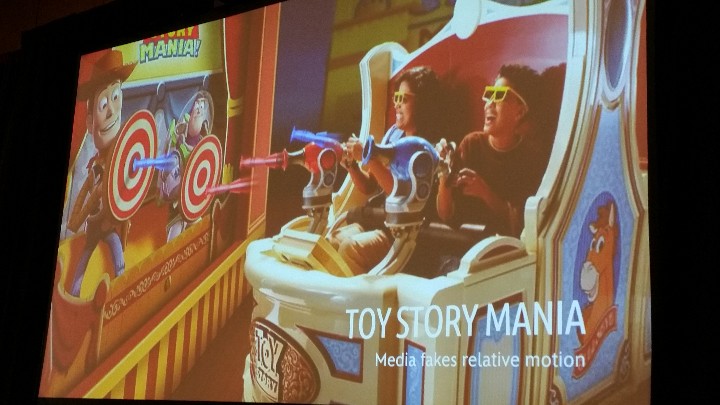
In addition to public-facing attractions, Disney Imagineering members have access to an internal development system known as the Digital Immersive Showroom aka The DISH. Again, multiple 4K projectors are used. However, instead of being immersed within a looping scene, this particular setup has more freedom involved. Designers and engineers can use The DISH to explore attractions, customizing them years before the rides are actually built. That Disney virtual reality simulator combines eye-limiting resolution projections with head tracking, 3D stereo glasses, a variety of handheld controllers, and proprietary software to produce cutting-edge development tools. In addition, Bei Yang mentioned during his GDC presentation that the system had 480Hz optical tracking and IMUs as well. So, depending on where a person stands in that room, their field of view can reach an astonishing 180 degrees.
https://www.youtube.com/watch?v=4lKysU6Ian0
As mentioned in the video above, virtual reality technologies at Disney started to take off around 2005 with the Finding Nemo Submarine Voyage. The original Submarine Voyage was built in 1959 as part of the re-vamped Tomorrowland attraction. It closed on September 9, 1998. At that time, reports came in that the attraction would reopen with a new theme by 2003.[3] The result was the Finding Nemo Submarine Voyage. Guests entered an actual underwater vehicle. They take a tour through an aquatic reef where they encounter the virtual characters from the film; including Nemo. People using Disney’s Digital Immersive Showroom developed parts of the ride. [4]
“Although the submarine is on a guideway, the helmsman controls its forward and backward movement via a small joystick to regulate these speeds (shown in RPMs, in lieu of the actual propeller which moves the boat) which vary in different sections of the ride. Cast members operating the submarines must guide the submarine through a series of laser sensors, each which activate a different scene for the show. Guiding timers and block-lights are placed throughout the ride to help the cast member properly time each scene. Helmsmen cast members are also able to unlock the watertight hatches via levers in the sail, which is done each time the boat arrives to dock. Each sail also carries a flashlight, opening/closing checklists for the ride’s opening/closing crew, and a radio to communicate with other boats and stations in the attraction.” [5]
A themed area called Cars Land was also developed in the Digital Immersive Showroom as well. Walt Disney Imagineering teams used the virtual reality technology to develop the environment well before they actually started building the landscape in the real world.
After tons of research, Disney designed and deployed these virtual reality-related attractions into the theme parks. They looked into the specifics of how the human eyes work. The rides utilized information about the way the ears track sounds like internal accelerometers. Resolution was always high. Consistent latency across the entire pipeline was predictably low, keeping guests comfortable during the experiences. Interactivity was a must. Making guests feel powerful was subtle and profound. Having the body as reference point was important. Groups of people from all ages could ride together, keeping the simulations social the whole way through. Bei Yang talked in-depth about the scientific findings discovered by Disney over the past 20 years. The full video is now available online in the GDC Vault. With all that information now public, questions from the audience started pouring in.
One guy at GDC asked about the ability of Disney’s systems to allow for more freedom during the attractions; and not putting them on pre-designated paths. The problem, as Yang stated, was that people usually come in groups with various levels of experience. Some might be trying out the rides for the first time, while others are returning users. The attractions are mostly geared toward those Disney ‘virgins.’ It is all about learn-ability for them. People must be able to easily pick up the systems, or else they might not have a good time. Designing for all ages is of mass important too. However, Yang did mention that Disney is looking at creating “expert systems” where returning users can switch out experiences like game cartridges on a console. The issue with that though is the specifics for tracking whether people are returning guests or not.
During the Q&A part of the dicussion, I questioned Yang about the hygiene issues that come with bringing HMDs to theme parks like Disney. He started off by joking that “pink eye is really contagious” and then went on to suggest possible solutions. For instance, if the lenses could be detached from the headsets, they could be easily cleaned. This would take large laundry facilities and extra cast members, but it would help address the hygiene problem.
Looking forward into the future of Disney’s attractions, more virtual reality-related experiences are sure to make their way into the theme parks. Exactly what those will look like have yet to be determined. There are reports though that Disney is considering re-creating entire attractions for VR headsets so that people can explore the rides even if they can’t physically make to the parks. An article by Venturebeat quotes Yang in saying that “yes, we are thinking about bringing the parks into VR. But in the end, we’re really just excited that there is another paint brush that we can use to tell our stories.” If the previous VR experiences by Disney are any sign of what is to come, the results of their future work is sure to be magical; so be on the lookout for what shows up next!

